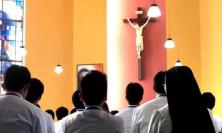Buying the Field is the final instalment of Sandra Schneiders’ trilogy on the theology of Religious Life. Weighing in at a hefty 658 pages with a further 103 of notes and bibliography, the book, like its predecessors Finding the Treasure and Selling All, requires a certain degree of commitment from the reader. However, the reward for patient, careful and attentive reading is that the reader finds herself being both enriched and challenged in equal measure.
Mt 13:44 is often cited within the Catholic Christian community as the scriptural basis for any theology of Religious Life (Schneiders always uses capital letters when referring to Religious Life as what she describes as a ‘lifeform’, rather than to the religious life lived by any believer), and it is that verse that acts as Schneiders’ ‘golden thread’ through all three volumes.
The kingdom of heaven is like treasure hidden in a field, which someone found and hid; then in his joy he goes and sells all that he has and buys that field.
It is unlikely that this field will ever be more comprehensively mined than in Schneiders’ work; this is no superficial, open-cast mining but a deep theological dig: ‘an examination, inter-disciplinary analysis and spirituality oriented theological interpretation of Catholic Religious Life as it has emerged and is continuing from the renewal of Vatican II’.
Schneiders is the kind of writer who follows the precept: tell them what you are going to tell them, tell them, and then tell them what you have told them! Given the depth and complexity of her work the reader is grateful for the regular ‘pitstops’, both within and at the end of chapters, to review the progress made thus far. In addition, these give enough of an overview of the two earlier works to ensure that even a reader who has not read these books has a clear sense of the place that they occupy in the overarching theology of Religious Life since the Second Vatican Council’s call to renewal. Some might find these summaries too frequent but I imagine most will be grateful for the opportunity to draw breath and be reminded of what has been laid before them.
Schneiders herself comments that when she undertook the project she could not have imagined it would take twelve years to bring to completion. Publication of Volume 3 came in 2013. This is significant in that, particularly in the final chapter of the book, ‘Transforming Renewal’, Schneiders makes more than passing reference to the increasing tensions in those years between female Religious Congregations (notably in her native USA) and the hierarchical Church. She has clear views on the attitudes of some members of the hierarchical Church in this area, which, to her credit, she does not allow to intrude on her treatment of her subject matter until that last chapter, which is written in a very different vein to the rest of the book. Given the dramatic events of 2013 in the Catholic Church and the new wind that appears to be blowing under the first Jesuit pope, one wonders if some of her concluding chapter might have been written differently in 2014…
However, the concluding chapter is only 50 of 650 pages. The context in which the rest of the book is written is Schneiders’ sense that the passage of 35 years (from the end of Vatican II until the beginning of her twelve year project) of renewal within Religious Life meant that it ‘was beginning to seem possible to get enough perspective to reflect, not simply on what Religious Life had once been but no longer was, but on what it was becoming’.
The particular focus of this volume is the interrelationship of those called to Religious Life and the world to which they are missioned. Fundamental to her whole treatment of the topic is her understanding of what is meant by ‘the world’ and of what is meant by the ‘mission’ of Religious – which is, fundamentally, a sharing in the mission of Jesus to bring about the Kingdom of God in ‘opposition to the Kingdom of Satan’ (p. 430). One thing that Schneiders and Pope Francis have in common is a clear understanding that Satan exists and is as intent on expanding his kingdom as Christians – not least Religious – are on bringing about the Kingdom of God.
This sharing of Religious in the mission of Jesus is articulated through vows – of consecrated celibacy (dealt with in Volume 2), of evangelical poverty and of prophetic obedience (both dealt with in this volume). Each vow is a particular response to what Schneiders describes as ‘the three fundamental co-ordinates of human existence – relationship, material goods and power’, which exist in ‘the world’. The first part of the book deals, through scriptural and theological exploration as always, with ‘the world’ in both its positive and less positive aspects, on the basis that Religious, through their vows, through the specific charism of their Congregation and through their mission, bring to ‘the world’ an ‘alternate world’ – one based on the values of the Kingdom.
The second and third parts of this volume deal with ‘evangelical poverty’ and ‘prophetic obedience’. It is noteworthy that she very seldom uses either noun without the adjacent adjective. Schneiders is clear that the adjectives are essential in distinguishing what is fundamental to those two vows from real poverty, the essence of which is not having a choice in relation to material possessions; and from other models of obedience which led to such devastating results in the totalitarian regimes of the mid-twentieth century. She speaks of evangelical poverty as the ‘economics of the Reign of God’ and of prophetic obedience as the ‘politics of the Reign of God’. Her methodology includes examining the three dimensions in which each of the vows functions – the mystical (or unitive), the communitarian and the ministerial.
In today’s world we are rightly wary of describing anything as ‘definitive’ and I have no doubt that Schneiders herself would be the first to eschew such an epithet if it were applied either to the latest volume or the whole trilogy. Indeed, her exposition is based precisely on the premise that, since the Second Vatican Council, Catholic Religious Life has moved out of its longstanding, definitive – not to mention highly inflexible and prescriptive – understanding of itself, to something much more developmental in its self-understanding. What cannot be debated is that this work is magisterial in both its scriptural and theological overview of Religious Life, and also in its depth. I imagine it will be a very long time before it is anything other than the touchstone for anyone seriously interested in or concerned with Religious Life and its continuing prophetic gift to the world and to the Church.
The reviewer, Sister Jane Livesey CJ, is General Superior of the Congregation of Jesus.






